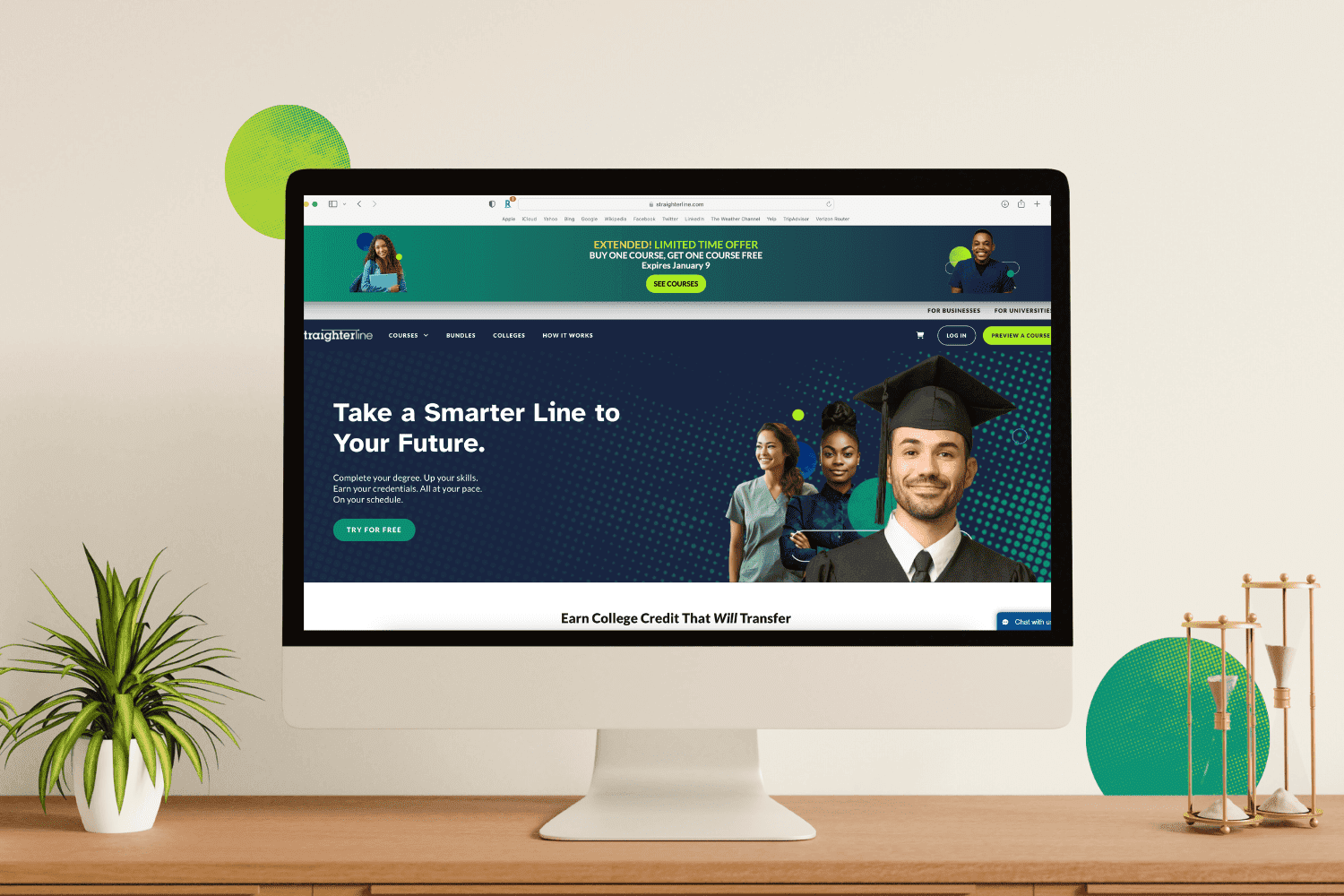Figuring out grants vs. loans vs. scholarships can be challenging, but we’ve got your back with everything you need to know to make higher education more affordable and within your reach. Knowing your college financial aid options can lighten the load when it comes to paying for college. That’s why the StraighterLine team put together this guide to walk you through the different types of financial aid available, the application process, extra resources, and tips for maximizing your aid so you’re ready to secure the funding you need for your education.
What Is Financial Aid?
To kick things off, college financial aid bridges the gap between your finances compared to the money you’ll need to cover your college costs. It includes grants, loans, scholarships, and work-study opportunities—each with its own perks, quirks, and eligibility requirements. We break it all down in more detail in the next section.
The Different Types of Financial Aid
Now that we’ve defined what financial aid is and why it’s crucial for so many students, let’s take a closer look at grants vs. loans vs. scholarships, and how the different types of aid compare to one another.
Grants
Grants are the golden ticket of financial aid—free money you don’t have to pay back. They are funded by federal and state governments, as well as colleges and private organizations. Although they’re typically awarded based on financial need, some grants may consider academic achievement or other criteria as a means for how they are distributed.
Examples of grants include Pell Grants and Federal Supplemental Education Opportunity Grants (FSEOG).
-
Pell Grants are need-based and awarded by the federal government to undergraduate students who haven’t yet earned their bachelor’s or professional degree. They’re dependent on cost of attendance, enrollment status, and the student’s financial need. Schools receive enough money from the Federal Pell Grant Program to guarantee money is awarded to all eligible students.
-
Federal Supplemental Educational Opportunity Grants (FSEOG) are also need-based and awarded to undergraduate students who demonstrate exceptional financial need. Where FSEOG differs from Pell Grants is that schools are allocated a fixed FSEOG budget each year to award on a first-come, first-served basis. Once the funds are distributed, they are done for the academic year. This means there’s a possibility that eligible students may miss out on this particular grant.
Scholarships
Like grants, scholarships are financial awards to help students pay for their education and don’t need to be repaid. They’re often awarded based on academic achievement, athletic ability, artistic talent, leadership qualities, financial need, or other criteria.
Merit-Based vs. Need-Based Scholarships
-
Merit-based scholarships are awarded based on a student’s accomplishments in areas such as academic performance, extracurricular involvement, or special talents and abilities. National Merit Scholarships and athletic scholarships are examples of merit-based awards.
-
Need-based scholarships are awarded based on a student’s financial need. Financial aid offices determine eligibility using data from the student’s FAFSA or other financial aid applications.
Tips for Finding and Applying for Scholarships
-
Get a jump on things and use those scholarship finders and databases like a pro—there’s free money out there with your name on it
-
Keep track of deadlines and tailor your application to each scholarship
-
Gather strong letters of recommendation and apply to as many as you can to boost your chances.
Loans
Loans are borrowed money you’ll need to pay back with interest. They’re offered by both the federal government and private lenders.
-
Federal loans typically offer lower interest rates and more flexible repayment options compared to private loans
-
Private loans are offered by banks, credit unions, and other private lenders. They often require a credit check and have higher interest rates and less flexible repayment terms than federal loans
The main benefit of loans is that they can open the door to education that otherwise might be out of reach. When looking at the cons, it’s no secret that paying back loans with interest can add up, and defaulting can hurt your credit score.
Work-Study Programs
Work-study programs are another financial aid option, providing students with financial need with part-time jobs, often related to their field of study.
Work-Study Program Benefits Include:
-
Financial support without piling on debt
-
Valuable work experience and networking opportunities
-
Flexible hours to fit around your classes
How to Apply for Financial Aid
Now it’s time to walk through how to apply for financial aid so you can get your finances for college straight and focus on hitting the books.
What Is FAFSA and Why Is It Important?
The FAFSA, or Free Application for Federal Student Aid, is your ticket to financial aid—which includes the previously mentioned grants, loans, and work-study programs. Filling it out opens up a world of funding opportunities that can significantly reduce the cost of your college education.
Step-by-Step Guide to Completing the FAFSA
-
Create an FSA ID: Your FSA ID is what will allow you to sign your FAFSA electronically. Head to studentaid.gov to get started.
-
Gather Necessary Documents: Your Social Security number, driver’s license (if you have one), federal income tax returns, W-2 forms, and records of untaxed income are among the documents you’ll need to fill out your FAFSA. If you’re a dependent student, you’ll also need your parents’ financial information.
-
Fill Out the FAFSA Application: Go to studentaid.gov, click on the “FAFSA Form” option, and then click the “Start New Form” button. Carefully go through the questions and fill in the information requested. Once you’ve completed the form, review the information for accuracy, and then sign the FAFSA using your FSA ID.
Remember, the FAFSA opens on October 1 each year and the federal deadline is typically June 30 of the following year. It’s best to apply as soon as possible to maximize your aid opportunities.
What is the CSS Profile and How Does It Differ From FAFSA?
The College Scholarship Profile (CSS) is an online application used by nearly 400 colleges and scholarship programs to award non-federal financial aid. Where the CSS differs from the FAFSA (which is free to fill out) is that applicants are required to pay a fee to fill it out. Fee waivers are available for eligible students. The CSS also requires more detailed information than the FAFSA, including information about assets, expenses, and special circumstances.
Many private colleges and universities, as well as some public institutions, require the CSS Profile for their own institutional aid, including Harvard, Stanford, and Duke. Be sure to check with each institution you’re applying to in order to determine if the CSS Profile is required.
Tips for Completing the CSS Profile
-
Start Early: The CSS profile opens on October 1—the same day as the FAFSA
-
Gather Detailed Financial Information: Collect documents such as tax returns, W-2 forms, bank statements, mortgage information, and records of untaxed income
-
Be Thorough and Accurate: Provide detailed and accurate information about your family’s financial situation. This includes special circumstances not captured by the FAFSA
-
Check for Errors: Review your application carefully before submitting to avoid mistakes
-
Don’t Be Shy About Asking Questions: Use the help resources available on the CSS Profile website or contact the financial aid office of the schools you’re applying to for assistance
Institutional Aid Applications
In addition to the FAFSA and CSS Profile, some colleges have their own institutional aid forms. These forms may request additional information not covered by the FAFSA or CSS Profile and are used to award funds directly from the college.
Each school has its own procedures and deadlines for applying for aid. It’s important to check the financial aid section of each institution’s website to understand their specific requirements and ensure you submit all necessary forms on time. Missing a deadline or failing to submit a required form can result in losing out on potential aid.
Understanding Financial Aid Offers
Once you receive financial aid award letters from colleges, you’ll need to know how to read and interpret them to make informed decisions. Financial aid award letters outline the types and amounts of aid you are eligible for, but that format and terminology can vary significantly between schools. Here are some key points to help you navigate these letters effectively.
How to Read and Interpret Financial Aid Award Letters
Financial aid award letters typically list the types of aid you’re offered, including grants, scholarships, loans, and work-study opportunities. Look for the total cost of attendance (COA), which includes tuition, fees, room and board, supplies, and personal expenses. Subtract the total amount of aid from the COA to determine your net price, which is the amount you’ll need to cover out-of-pocket or through other means.
Comparing Financial Aid Offers from Different Schools
When comparing offers from different schools, focus on the net price rather than the total amount of aid. A higher aid package might still result in a higher net price if the COA is significantly higher. Pay attention to the types of aid offered. Grants and scholarships are preferable since they do not need to be repaid, whereas loans will add to your debt burden. Also, consider the terms and conditions of work-study programs, such as the number of hours you’re expected to work.
Understanding the Cost Attendance and Net Price
The COA includes all the expenses associated with attending college for one year. It’s essential to understand what each component of the COA covers to ensure you budget accurately. The net price is what you'll actually pay after accounting for all the financial aid you’ve received. Use net price calculators available on college websites to estimate your net cost and compare it with other schools. Understanding the COA and net price helps you make a more informed decision about which college is financially feasible for you.
Additional Financial Aid Resources
Beyond federal aid, there are several other financial aid resources available to students.
State and local financial aid programs often provide grants and scholarships based on a student’s residency, academic achievement, or financial need. You should check with your state’s education department or local government for specific opportunities.
Employer tuition assistance programs are another valuable resource. Many companies offer financial support for employees or their dependents to further their education. It’s worth asking your (or your parent’s) employer about such benefits.
Military and veteran benefits provide significant educational assistance through programs like the GI Bill, which offers tuition and housing for veterans and their families. Additionally, ROTC scholarships and military-specific grants can cover substantial costs.
Tips for Maximizing Financial Aid
One of the most important tips for securing grants, loans, and scholarships is to apply early and meet all deadlines. Many aid programs operate on a first-come, first-served basis, so submitting your application promptly can increase the amount of aid you receive.
Searching for external scholarships is another effective strategy for maximizing aid. Use scholarship search engines, local community resources, and professional organizations to find additional opportunities to make the cost of your education more manageable.
Don’t hesitate to negotiate your aid package with your chosen college’s financial aid office if your circumstances change or if you receive a more favorable offer from another institution.
Also, it’s up to you to ensure you maintain your eligibility for aid by meeting academic progress requirements and maintaining your enrollment status.
Common Myths About Financial Aid
Many students and families are deterred from applying for financial aid due to some of the myths and misconceptions around the topic.
Myth: “I make too much money to qualify for aid.”
Reality: Aid is available for a variety of income levels. Many factors beyond income are considered, including family size and number of college-going children in a household.
Myth: “Only students with perfect grades get scholarships.”
Reality: While some scholarships are merit-based, many are awarded based on financial need, community service, or specific talents and interests.
Myth: “Applying for aid is too complicated.”
Reality: With financial aid resources and assistance from school counselors and aides, the process can be manageable.
Myth: “I have to repay ALL financial aid received.”
Reality: Grants and scholarships don’t need to be repaid, and there are a variety of loan repayment options available to students.
Financial Aid for Special Circumstances
Financial aid options are available for students in various unique situations, ensuring everyone has the opportunity to pursue higher education.
Nontraditional students, such as part-time and adult learners, can access aid through federal programs—including Pell Grants and Direct Loans. Many colleges also offer scholarships specifically for adult learning or those returning to school.
International students may have fewer federal aid options, but many universities provide institutional scholarships and grants. Additionally, private organizations and international foundations often offer scholarships based on merit or specific criteria.
Students with disabilities can access additional financial aid through various sources. The federal government offers grants like the FSEOG, and many colleges have scholarships designated for students with disabilities. Organizations like the National Federation of the Blind and the Autism Society also provide scholarships to support students in their educational pursuits. By exploring these options, students in diverse circumstances can find the financial support they’re looking for.
Save Even More on Your Tuition with StraighterLine
As you’re thinking about the cost of college, it’s helpful to know that StraighterLine offers more than 75 affordable online college courses you can take to knock out prereq and gen ed courses on your own time and at your own pace, all while cutting thousands off the cost of your tuition. More than 350,000 students have taken our ACE accredited courses and successfully transferred the credits they earned through StraighterLine to more than 3,000 schools.
Here’s a guide we put together to help you navigate the most affordable route to your college degree.












